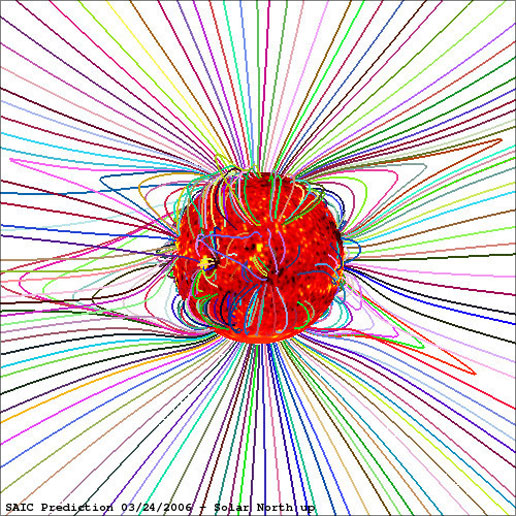
An artist's concept of what the heliospheric current sheet might do when the sun's magnetic field flips. Via Professor John Wilcox and Werner Heil
The Sun may look stoic and unchanging from our Earthly vantage point, but it’s not. Not only is the hot ball of gas around which we orbit externally dynamic with coronal mass ejections and sunspots, it’s internally dynamic, too. The hot plasma that makes up our star is conductive, generating a magnetic field. And in three or four months, that magnetic field is going to flip.
This flip isn’t unexpected; the Sun’s polarity actually changes every 11 years (Earth years, that is) as part of the regular solar cycle. At the peak of each cycle, the Sun’s internal material reorganizes itself, changing the star’s polarity.
It’s predicted, but the flip is still a big deal. The effects of the flip will quite literally ripple throughout the Solar System.
There exists something solar physicists call a heliospheric current sheet. It’s a surface of sorts that juts out from the Sun’s equator, rooted where the Sun’s slowly rotating magnetic field induces an electrical current. It’s a low current, but it’s steady, and it extends, like a sheet, well beyond the orbit of Pluto.

Visualization of the Sun's magnetic field, with its north pole on top. Via NASA
It’s around this sheet that the Sun’s whole magnetic influence, properly called the heliosphere, is organized. As Earth orbits the Sun, it dips in and out of the current sheet. Changes in the electrical environment as the planet transitions from one side of the sheet to the other can stir up stormy space weather in our vicinity.
When the Sun’s poles flips, the sheet will ripple, becoming temporarily very wavy. And that’s potentially good news. The current sheet normally protects the Earth and our Solar System from cosmic rays—the high-energy particles shot out at near light speed by supernova explosions and other violent events that typically threaten the health of astronauts and space probes—by deflecting them. It’s possible that a wavy, crinkly current sheet will act as a better shield against these energetic particles from deep space.
Astronomers and solar physicists know the flip is imminent because the poles are already showing the first signs of change. Magnetograms at Stanford's Wilcox Solar Observatory have been tracking the Sun's polar magnetism since 1976 and monitor the Sun's magnetic field daily. The poles are already out of sync—the north pole has changed its sign and soon the south pole will change its.
As this happens, the polar magnetic field weakens and disappears. When the Sun’s material reorganizes itself and the poles return reversed, the magnetic field also returns with the opposite polarity. It will be the sure sign that a solar maximum is behind us and the second half of a solar cycle is beginning.
We’ll have eyes in the sky monitoring this change. Earth based observatories will certainly continue taking measurements, and NASA’s twin Voyager spacecraft might also get in on the action. The Voyager spacecraft, those 35-year-old robotic planetary explorers that are racing towards the edge of the heliosphere, will hopefully tell us what that rippling sheet looks like from billions of miles away.
So this flip is cosmically exciting and will be interesting to observe from space, but the rest of us Earth bound watchers won’t notice a thing.
